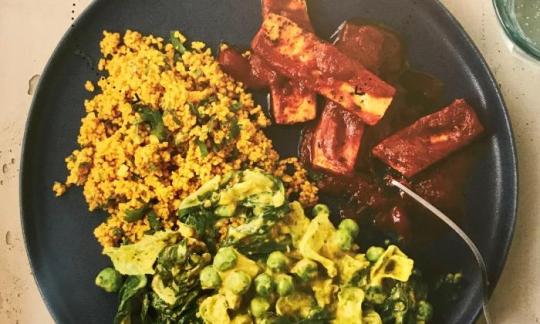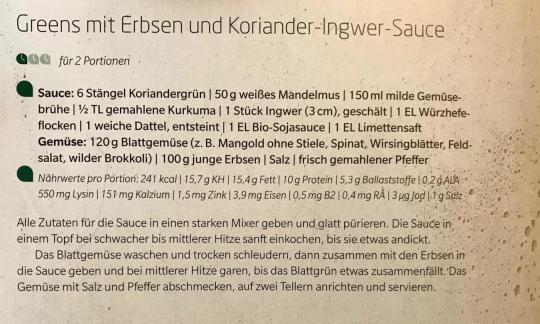Swiss chard greens with peas and coriander-ginger sauce
vegan
Ingredients (for servings, )
| For the sauce | |
|---|---|
| 6 sprigs | Coriander leaves, raw (0.47 oz) |
| 3 cm | Ginger, raw (organic?) (1.1 oz) |
| 1 ¾ oz | White almond butter, raw? (organic?) |
| 150 ml | Vegetable broth without added salt (organic?) (5.2 oz) |
| ½ tsp | Turmeric (saffron root), ground, raw (organic?) (0.05 oz) |
| 1 tbsp | Yeast flakes: noble yeast, nutritional yeast, yeast powder (raw?, organic?) (0.10 oz) |
| 1 | Dates, Medjool variety, pitted, raw? (organic?) (0.84 oz) |
| 1 tbsp | Reduced salt soy sauce (Genen-Shoyu, organic?, raw?) (0.56 oz) |
| 1 tbsp | Lime juice (raw?, organic?) (0.25 oz) |
| For the vegetables | |
| 4 ⅓ oz | Swiss chard / chard (raw, organic?) |
| 3 ½ oz | Peas, green, raw (organic?) |
| 1 dash | Table salt (table salt, raw?, organic?) (0.01 oz) |
| 1 dash | Black pepper (organic?, raw?) (0.00 oz) |
Equipment
- blender
- grater
- stove
- saucepan
- salad spinner
Type of preparation
- cook
- season to taste
- can (bottle)
- purée
- grate (shred)
- drain
Preparation
For the sauce
Clean the coriander. Peel and grate the ginger.
Place all ingredients in a strong blender and puree until smooth.The authors specified organic soy sauce - we used the low-salt version. To further reduce the salt content, we also used extra low-salt vegetable broth (see "Alternative preparation").
Transfer the resulting sauce to a saucepan and simmer gently over low to medium heat until it thickens slightly.
For the vegetables
Wash the chard, spin it dry and remove the stalks. Then add it to the sauce with the peas and cook over a medium heat until the leaves wilt a little.Instead of chard, or in addition to it, you can choose other leafy vegetables such as spinach, savoy cabbage leaves, lamb's lettuce, wild broccoli or rocket. The preparation time varies accordingly.
Season the vegetables with salt and pepper, arrange on two plates and serve.
|
Nutritional Information per person
Convert per 100g
|
2000 kcal | |
|---|---|---|
| Energy | 300 kcal | 15.0% |
| Fat/Lipids | 17 g | 24.4% |
| Saturated Fats | 2.2 g | 11.0% |
| Carbohydrates (inc.dietary fiber) | 29 g | 10.6% |
| Sugars | 14 g | 15.7% |
| Fiber | 8.3 g | 33.2% |
| Protein/Albumin | 11 g | 22.5% |
| Cooking Salt (Na:479.0 mg) | 1'217 mg | 50.7% |
| Essential micronutrients with the highest proportions | per person | 2000 kcal | |
|---|---|---|---|
| Vit | Vitamin K | 538 µg | 718.0% |
| Vit | Vitamin B1 (Thiamine) | 0.81 mg | 74.0% |
| Sodium, Na | 480 mg | 60.0% | |
| Min | Manganese, Mn | 1.2 mg | 58.0% |
| Vit | Vitamin C (ascorbic acid) | 44 mg | 56.0% |
| Min | Copper, Cu | 0.55 mg | 55.0% |
| Vit | Vitamin E, as a-TEs | 6.0 mg | 50.0% |
| Elem | Magnesium, Mg | 154 mg | 41.0% |
| Elem | Potassium, K | 761 mg | 38.0% |
| Vit | Vitamin A, as RAE | 300 µg | 38.0% |
Detailed Nutritional Information per Person for this Recipe
The majority of the nutritional information comes from the USDA (US Department of Agriculture). This means that the information for natural products is often incomplete or only given within broader categories, whereas in most cases products made from these have more complete information displayed.
If we take flaxseed, for example, the important essential amino acid ALA (omega-3) is only included in an overarching category whereas for flaxseed oil ALA is listed specifically. In time, we will be able to change this, but it will require a lot of work. An “i” appears behind ingredients that have been adjusted and an explanation appears when you hover over this symbol.
For Erb Muesli, the original calculations resulted in 48 % of the daily requirement of ALA — but with the correction, we see that the muesli actually covers >100 % of the necessary recommendation for the omega-3 fatty acid ALA. Our goal is to eventually be able to compare the nutritional value of our recipes with those that are used in conventional western lifestyles.
| Essential fatty acids | per person | 2000 kcal |
|---|---|---|
| Linoleic acid; LA; 18:2 omega-6 | 3.5 g | 35.0% |
| Alpha-Linolenic acid; ALA; 18:3 omega-3 | 0.06 g | 3.0% |
| Essential amino acids | per person | 2000 kcal |
|---|---|---|
| Threonine (Thr, T, irreversibly transaminated) | 0.31 g | 34.0% |
| Isoleucine (Ile, I) | 0.41 g | 33.0% |
| Tryptophan (Trp, W) | 0.08 g | 30.0% |
| Phenylalanine (Phe, F) | 0.45 g | 29.0% |
| Valin (Val, V) | 0.47 g | 29.0% |
| Leucine (Leu, L) | 0.61 g | 25.0% |
| Lysine (Lys, K, irreversibly transaminated) | 0.39 g | 21.0% |
| Methionine (Met, M) | 0.12 g | 13.0% |
| Vitamins | per person | 2000 kcal |
|---|---|---|
| Vitamin K | 538 µg | 718.0% |
| Vitamin B1 (Thiamine) | 0.81 mg | 74.0% |
| Vitamin C (ascorbic acid) | 44 mg | 56.0% |
| Vitamin E, as a-TEs | 6.0 mg | 50.0% |
| Vitamin A, as RAE | 300 µg | 38.0% |
| Vitamin B9, B11 (Folate, as the active form of folic acid) | 70 µg | 35.0% |
| Vitamin B3 (Niacin) | 3.6 mg | 22.0% |
| Vitamin B2 (Riboflavin) | 0.27 mg | 20.0% |
| Vitamin B6 (pyridoxine) | 0.27 mg | 20.0% |
| Vitamin B5 (Pantothenic acid) | 0.67 mg | 11.0% |
| Vitamin B7 (Biotin, ex vitamin H) | 3.4 µg | 7.0% |
| Essential macroelements (macronutrients) | per person | 2000 kcal |
|---|---|---|
| Sodium, Na | 480 mg | 60.0% |
| Magnesium, Mg | 154 mg | 41.0% |
| Potassium, K | 761 mg | 38.0% |
| Calcium, Ca | 155 mg | 19.0% |
| Phosphorus, P | 114 mg | 16.0% |
| Essential trace elements (micronutrients) | per person | 2000 kcal |
|---|---|---|
| Manganese, Mn | 1.2 mg | 58.0% |
| Copper, Cu | 0.55 mg | 55.0% |
| Iron, Fe | 3.5 mg | 25.0% |
| Zinc, Zn | 1.9 mg | 19.0% |
| Selenium, Se | 1.7 µg | 3.0% |
| Iod, I (Jod, J) | 4.7 µg | 3.0% |
| Fluorine, F | 25 µg | 1.0% |
Dorling Kindersley Verlag GmbH / Penguin Random House Gruppe, Sebastian Copien
Raw recipes 10, Cooked recipes 79 (3)
Additional photos (6)
"Goodbye Vegan Clichés! The Cookbook - Compact Knowledge, Delicious Recipes" contains creative and healthy recipes for vegans and those who want to become vegan.
Since this book is written in German, a description is omitted here. If you are interested, please switch to German in the menu.
You can prepare the chard greens with peas and coriander-ginger sauce with different leafy vegetables.
Nutrient profile: According to GDA guidelines, one portion of this recipe covers several times the average daily requirement of vitamin K, vitamin B1 and folic acid.
However, the vegetables lose some of their nutrients when heated during cooking. Since the nutrient profile refers to the uncooked ingredients, the values are actually somewhat lower.
Swiss chard: Both the stems and the leaves of Swiss chard are edible. It tastes like spinach, but is more intense and bitter. Like spinach, Swiss chard has a high oxalic acid content.
Almond butter: White almond butter consists of blanched almond kernels, while brown almond butter is usually made of roasted almonds with skin. As a result, the darker version has a more intense flavor, while the lighter version has a finer consistency and a milder aroma.
Turmeric: While fresh turmeric has a resinous, slightly burning taste, dried turmeric is milder, even slightly bitter, and is used primarily for its coloring power. Turmeric, which comes from South Asia, belongs to the ginger family. The rhizome is very similar to ginger, but has an intense yellow-orange color, which it owes to the curcumin.
Ginger: Ginger is aromatic and has a sharp, spicy taste, which is due to the pungent substance gingerol. As a cooking ingredient, the ginger root is used in various forms, including fresh, dried and ground.
Yeast flakes: Normal yeast flakes, also So-called noble yeast, it consists of inactivated yeast (single-celled fungi) that is first dried and then processed into small flakes. Noble yeast is used in the kitchen for low-sodium seasoning and thickening of soups, sauces, salads and for sprinkling on savory dishes.
Menu composition: This dish is suitable, for example, in combination with Golden Milk Couscous and Umami Tofu (see page 141 or page 201 of the same book).
Oxalic acid and kidney stones: Kidney stones are stone-like deposits in the calyx system of the kidney and in the renal pelvis. These can form through the crystallization of certain substances such as calcium oxalate and uric acid. Reasons for this include the presence of these substances in increased concentrations, pH changes in the urine, drainage obstructions or urinary tract infections. For this reason, people at risk of developing kidney stones should drink enough fluids and not eat too large quantities of foods containing oxalic acid ( parsley, purslane, cassava, amaranth, spinach or chard). This also applies to people with hyperabsorption (= very high absorption) of oxalate or hyperoxaluria (high increase and increased excretion of oxalic acid in the urine). Oxalic acid also makes it difficult to absorb iron, which is why iron tablets should not be taken at the same time as the above-mentioned foods during iron therapy.
Leafy vegetables: You can choose other leafy vegetables instead of chard, or in addition to it, such as spinach, savoy cabbage leaves, lamb's lettuce, wild broccoli or arugula.
Low-salt vegetable stock: We use extra low-salt vegetable stock to reduce the overall amount of salt without sacrificing flavor. Use your own preference as a guide when adding salt to this dish.
Homemade vegetable stock: By making salt-free vegetable stock, the salt content can be significantly reduced. Access our recipe via this link: Vegan vegetable stock.
Read more at: Vegans often eat unhealthily. Avoidable nutritional errors.






